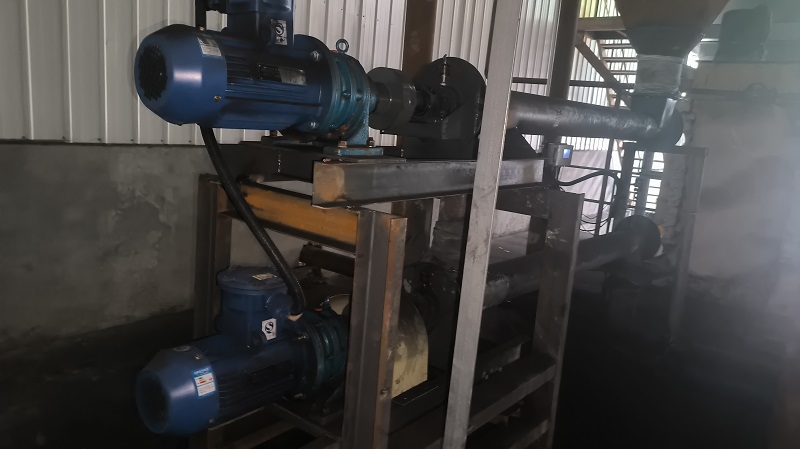
What's the measurement range of screw feeders? What's their power? How's the flow stabilization?
In industrial production, quantitative feeders are commonly encountered, which convey and weigh materials while controlling the quantity. They are widely used in coal mines, agriculture, food, chemicals, and other fields. Quantitative feeders come in various types, and screw feeders are particularly suitable for materials with certain moisture content or powder materials. Screw feeders are a new generation of products that integrate powder material conveyance, weighing, and quantitative control. Many customers know about screw feeders but are not familiar with the details. They often ask about the measurement range, power, and flow stabilization of our screw feeders. Today, let's delve into the lesser-known aspects of screw feeders.

Measurement Range of Screw Feeders
The measurement range, or weighing capacity, refers to the minimum and maximum weights that can be accurately measured. Considering the 2-meter conveying length of screw feeders, a too-low hourly throughput would result in quick material passage through the screw tube, making accurate measurement difficult. Therefore, to ensure accuracy, Guonuo Technology has determined through testing that the minimum weighing capacity is set at 500KG/H.
Weighing Length of Screw Feeders
The weighing length is the distance over which the material exerts an equivalent influence on the weighing sensor as it passes. It's the section where the material's weight is fully transferred to the weighing sensor and support points. Unlike belt conveyors, screw feeders vary in length from a few meters to over ten meters. If the length is too short, the weighing length might exceed the machine's physical length, compromising accuracy. Additionally, material conveyance in screw feeders relies on motor power. If the body is too long, material flow may be obstructed. Guonuo Technology has determined through testing that the optimal conveying length for screw feeders is 2 to 10 meters.
Power of Screw Feeders
The power of screw feeders refers to the motor power, which is customized based on actual on-site production requirements, including the hourly material throughput and conveying length. Typically, motor powers range from 1.1KW to 10KW. For instance, a 1.1KW motor is sufficient for a 3-meter screw feeder with a 500KG/H throughput. Be cautious if a supplier provides a definitive motor power without considering your specific needs; they may lack professionalism.
Flow Stabilization in Screw Feeders
A common issue with screw feeders is material blockage and arching. Effective flow stabilization is crucial for uniform material conveyance and accurate measurement. Guonuo Technology's screw feeders feature a unique flow stabilization structure that ensures powder material sinks uniformly across the feed inlet section, preventing arching and material surging. The screw blades are crafted from manganese steel, offering high wear resistance and small gaps to prevent material adhesion and backflow.
Understanding the measurement range, weighing length, motor power, and flow stabilization of screw feeders is essential for both purchasing and daily maintenance.
 The Application Superiority of the Unmanned Automatic Weighing Management System for Truck Scales
The Application Superiority of the Unmanned Automatic Weighing Management System for Truck Scales
 Unmanned Automatic Weighbridge System vs. Traditional Manual Weighbridge
Unmanned Automatic Weighbridge System vs. Traditional Manual Weighbridge
 System Composition and System Characteristics of Electronic Batching Belt Scales
System Composition and System Characteristics of Electronic Batching Belt Scales
 Why can the Guonuo ICS-14A Electronic Belt Scale be used as a belt scale for trade settlement?
Why can the Guonuo ICS-14A Electronic Belt Scale be used as a belt scale for trade settlement?
 Hardware Composition and Software Functions of Automated Batching Control Systems
Hardware Composition and Software Functions of Automated Batching Control Systems
 In which aspects can electronic explosion-proof belt scales better meet the weighing and metering needs of coal mines?
In which aspects can electronic explosion-proof belt scales better meet the weighing and metering needs of coal mines?
 What are the sources of error in the application of in-furnace coal belt weighers? How can they be resolved?
What are the sources of error in the application of in-furnace coal belt weighers? How can they be resolved?
 What brand of loader weighing electronic scale has good quality? How should one choose?
What brand of loader weighing electronic scale has good quality? How should one choose?
 How can mines achieve unmanned management of weighbridge weighing?
How can mines achieve unmanned management of weighbridge weighing?
